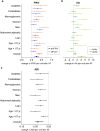Advanced glycation end-products, measured as skin autofluorescence, associate with vascular stiffness in diabetic, pre-diabetic and normoglycemic individuals: a cross-sectional study
- PMID: 34176469
- PMCID: PMC8236143
- DOI: 10.1186/s12933-021-01296-5
Advanced glycation end-products, measured as skin autofluorescence, associate with vascular stiffness in diabetic, pre-diabetic and normoglycemic individuals: a cross-sectional study
Abstract
Background: Advanced glycation end-products are proteins that become glycated after contact with sugars and are implicated in endothelial dysfunction and arterial stiffening. We aimed to investigate the relationships between advanced glycation end-products, measured as skin autofluorescence, and vascular stiffness in various glycemic strata.
Methods: We performed a cross-sectional analysis within the European Prospective Investigation into Cancer and Nutrition (EPIC)-Potsdam cohort, comprising n = 3535 participants (median age 67 years, 60% women). Advanced glycation end-products were measured as skin autofluorescence with AGE-Reader™, vascular stiffness was measured as pulse wave velocity, augmentation index and ankle-brachial index with Vascular Explorer™. A subset of 1348 participants underwent an oral glucose tolerance test. Participants were sub-phenotyped into normoglycemic, prediabetes and diabetes groups. Associations between skin autofluorescence and various indices of vascular stiffness were assessed by multivariable regression analyses and were adjusted for age, sex, measures of adiposity and lifestyle, blood pressure, prevalent conditions, medication use and blood biomarkers.
Results: Skin autofluorescence associated with pulse wave velocity, augmentation index and ankle-brachial index, adjusted beta coefficients (95% CI) per unit skin autofluorescence increase: 0.38 (0.21; 0.55) for carotid-femoral pulse wave velocity, 0.25 (0.14; 0.37) for aortic pulse wave velocity, 1.00 (0.29; 1.70) for aortic augmentation index, 4.12 (2.24; 6.00) for brachial augmentation index and - 0.04 (- 0.05; - 0.02) for ankle-brachial index. The associations were strongest in men, younger individuals and were consistent across all glycemic strata: for carotid-femoral pulse wave velocity 0.36 (0.12; 0.60) in normoglycemic, 0.33 (- 0.01; 0.67) in prediabetes and 0.45 (0.09; 0.80) in diabetes groups; with similar estimates for aortic pulse wave velocity. Augmentation index was associated with skin autofluorescence only in normoglycemic and diabetes groups. Ankle-brachial index inversely associated with skin autofluorescence across all sex, age and glycemic strata.
Conclusions: Our findings indicate that advanced glycation end-products measured as skin autofluorescence might be involved in vascular stiffening independent of age and other cardiometabolic risk factors not only in individuals with diabetes but also in normoglycemic and prediabetic conditions. Skin autofluorescence might prove as a rapid and non-invasive method for assessment of macrovascular disease progression across all glycemic strata.
Keywords: AGE; Advanced glycation end-products; Ankle-brachial index; Augmentation index; Glycemia; Prediabetes; Pulse wave velocity; Skin autofluorescence; Vascular stiffness.
Conflict of interest statement
The authors declare that they have no competing interests.
Figures



Similar articles
-
Skin Autofluorescence and Pentosidine Are Associated With Aortic Stiffening: The Maastricht Study.Hypertension. 2016 Oct;68(4):956-63. doi: 10.1161/HYPERTENSIONAHA.116.07446. Epub 2016 Aug 22. Hypertension. 2016. PMID: 27550921
-
Are Advanced Glycation End Products in Skin Associated with Vascular Dysfunction Markers? A Meta-Analysis.Int J Environ Res Public Health. 2020 Sep 22;17(18):6936. doi: 10.3390/ijerph17186936. Int J Environ Res Public Health. 2020. PMID: 32972023 Free PMC article.
-
Central arterial stiffness is associated with systemic inflammation among Asians with type 2 diabetes.Diab Vasc Dis Res. 2016 Jul;13(4):303-6. doi: 10.1177/1479164116635021. Epub 2016 Apr 18. Diab Vasc Dis Res. 2016. PMID: 27190079
-
Advanced glycation end products, aortic stiffness, and wave reflection in peritoneal dialysis as compared to hemodialysis.Int Urol Nephrol. 2014 Apr;46(4):817-24. doi: 10.1007/s11255-013-0597-6. Epub 2013 Nov 17. Int Urol Nephrol. 2014. PMID: 24242737
-
The Association between Inflammation and Pulse Wave Velocity in Dyslipidemia: An Evidence-Based Review.Mediators Inflamm. 2020 Aug 18;2020:4732987. doi: 10.1155/2020/4732987. eCollection 2020. Mediators Inflamm. 2020. PMID: 32908450 Free PMC article. Review.
Cited by
-
Staphylococcus aureus Biofilm Inhibiting Activity of Advanced Glycation Endproduct Crosslink Breaking and Glycation Inhibiting Compounds.Antibiotics (Basel). 2022 Oct 14;11(10):1412. doi: 10.3390/antibiotics11101412. Antibiotics (Basel). 2022. PMID: 36290070 Free PMC article.
-
Type 2 diabetes and depression via microvascular dysfunction, neurodegeneration, inflammation, advanced glycation end products (AGEs), and arterial stiffness.Diabetes Obes Metab. 2025 Sep;27(9):4847-4858. doi: 10.1111/dom.16527. Epub 2025 Jun 19. Diabetes Obes Metab. 2025. PMID: 40536118 Free PMC article.
-
Vascular Aging: Assessment and Intervention.Clin Interv Aging. 2023 Aug 17;18:1373-1395. doi: 10.2147/CIA.S423373. eCollection 2023. Clin Interv Aging. 2023. PMID: 37609042 Free PMC article. Review.
-
Implications of receptor for advanced glycation end products for progression from obesity to diabetes and from diabetes to cancer.World J Diabetes. 2023 Jul 15;14(7):977-994. doi: 10.4239/wjd.v14.i7.977. World J Diabetes. 2023. PMID: 37547586 Free PMC article. Review.
-
Effects of minute oscillation stretching training on muscle and tendon stiffness and walking capability in people with type 2 diabetes.Eur J Appl Physiol. 2025 Jan;125(1):183-195. doi: 10.1007/s00421-024-05596-y. Epub 2024 Sep 9. Eur J Appl Physiol. 2025. PMID: 39249539 Free PMC article.
References
Publication types
MeSH terms
Substances
LinkOut - more resources
Full Text Sources
Medical

